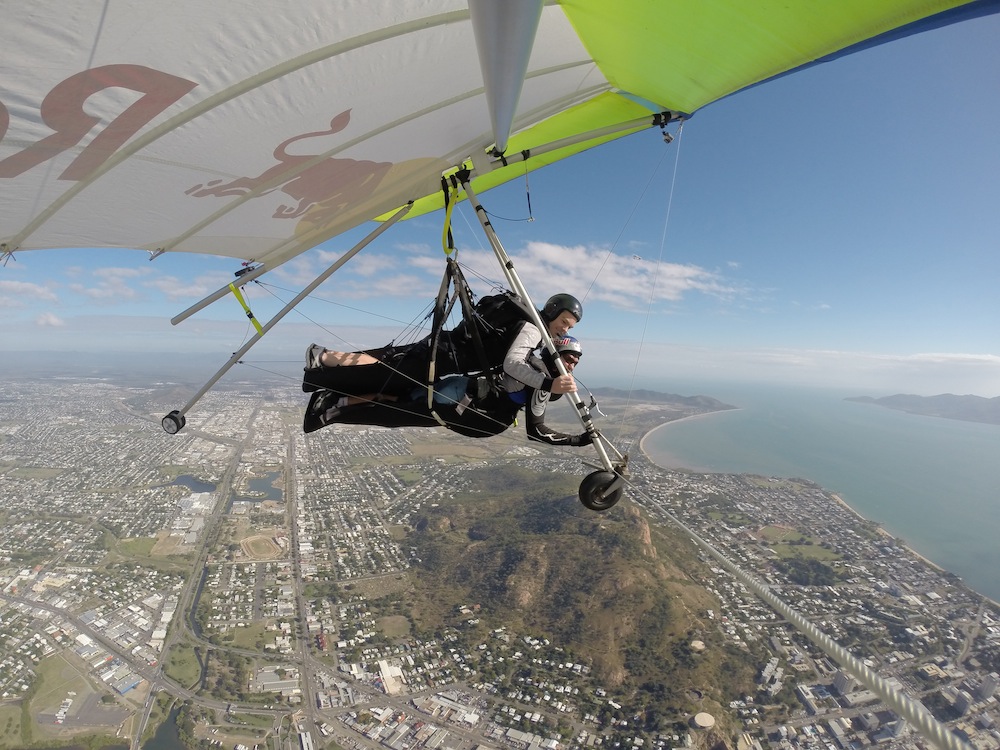Hang Glider Aims to Break Long-Distance Flight Record

A daring hang glider known for his extreme stunts and record-setting flights will soon attempt to set another record for the longest open-distance flight.
On or soon after Monday (June 20), Jonny Durand will attempt to glide from Zapata, in southern Texas, to Lorenzo, in northern Texas, a distance of about 475 miles (764 kilometers). Aiding him on his journey — on (or around) the summer solstice, the longest day of the year — are what may be ideal atmospheric conditions for long-distance hang gliding on Earth.
"What we look for with this particular world distance record is a location that is generally hot and dry," Durand told Live Science. "The first time I went to Zapata, the front page of the newspaper for 40 days in a row said it was more than 100 degrees F [37.7 degrees C]." [Hyperloop, Jetpacks & More: 9 Futuristic Transit Ideas]
Hot, dry landscapes such as those in Texas generate thermals, or rising columns of hot air. Such thermals help keep hang gliders aloft. "The fastest thermal I've ever climbed took me up 1,500 to 1,600 feet [450 to 490 meters] in a minute," Durand said. "Most elevators only rise at about 200 feet [60 m] per minute."
Texas thermals
Zapata is also home to winds "that blow in a pretty straight line for a long distance," Durand said. "It's why world hang-gliding records have been set here for the past 15, 16 years."
"[At] most places on Earth, weather systems change every few hundred miles or so, but by Zapata, the winds are very strong and steady for 500 miles [805 km] or more in a straight line," said Gary Osoba, an aerospace engineer and atmospheric physicist who recently retired from Google. Osoba previously set numerous world gliding records himself.
Osoba discovered the qualities that make Zapata a hang-gliding paradise. "I studied 20 years of climate data that had been archived on the location," he told Live Science. "I had a pretty good idea of how ideal it'd be, based on its relationship to air masses, summer weather patterns, so on and so forth."
Sign up for the Live Science daily newsletter now
Get the world’s most fascinating discoveries delivered straight to your inbox.
Zapata is located at the meeting place of two very different air masses, Osoba said. One originates from the Pacific, and as it crosses over Mexico, it goes up and down several mountain ranges, which causes it to lose water, making it "very dry and stable; it doesn't want to rise," Osoba said. The other is a high-pressure air mass from the Atlantic, and as it circulates, "it pulls unstable, moist air from the Gulf of Mexico inland."
The point where these two air masses meets is called a dry line. In the Great Plains of North America, the dry line can generate a lot of atmospheric instability in the form of thunderstorms and tornados. However, at Zapata, the dry line can generate ideal atmospheric conditions for gliding, Osoba said. [Images: One-of-a-Kind Places on Earth]
"At other good locations for gliding activity in the world, you might only get five- or six-hour flights, but at Zapata, you can often get an 11- or 12-hour flight," Osoba said.
Gliding for a record
Durand currently holds three hang-gliding world records. In 2012 in Texas, he reached a record distance of 346 miles (557 km) to a prearranged destination, beating the previous record of 321.4 miles (517.2 km). Later, in 2014 in Australia, he reached a speed of 44.29 mph (71.28 km/h) over a round trip of 186 miles (300 km) and a speed of 56.18 mph (90.41 km/h) over a round trip of 62 miles (100 km), smashing the previous records over those distances of 34.8 mph (56 km/h) and 46.6 mph (75 km/h), respectively. [Gallery of Wonders: The Weirdest World Records]
Now, Durand hopes to set a new world hang-gliding record for the longest open-distance flight — that is, flying as far as he can without a declared goal. He came very close to setting the record in 2012, only to fall short by a few miles to Dustin Martin's current record of 474.7 miles (764 km).
The current hang-gliding record for longest open-distance flight was set from Zapata. Durand's previous attempt to set the record took place from Zapata as well.
Summer solstice flight
On Monday, Durand will be looking for strong winds, "but not too strong, since you can't fly if it's too strong; we're looking for the 20 mph (32 km/h) range. We're also looking at how much instability there is in the air, and the height that thermals are going to — the higher the better, since it means less time spent looking for another thermal to stay up in the air, and they can be tricky to find," he said.
There are many clues that hang gliders use to look for thermals. For instance, white puffy cumulus clouds are located at the heads of thermals — they originate from the way that moist air in thermals cools down as it rises upward, condensing into the water droplets that make up clouds, Osoba said.
The flight may take about 11 hours with Durand wearing a tight harness, he said. He plans to leave a few hours after sunrise in order to give the ground time to heat up and generate thermals. During the flight, he will drink water from a tube and eat a few snacks at most, "and in case I have to go to the bathroom, I can unzip midair," he said.
And Durand hopes to fly on or around the summer solstice. "You want the longest day of the year because, it gives you longer to fly," Durand said. "We're hoping for the right conditions for breaking a world distance record."
Original article on Live Science.










